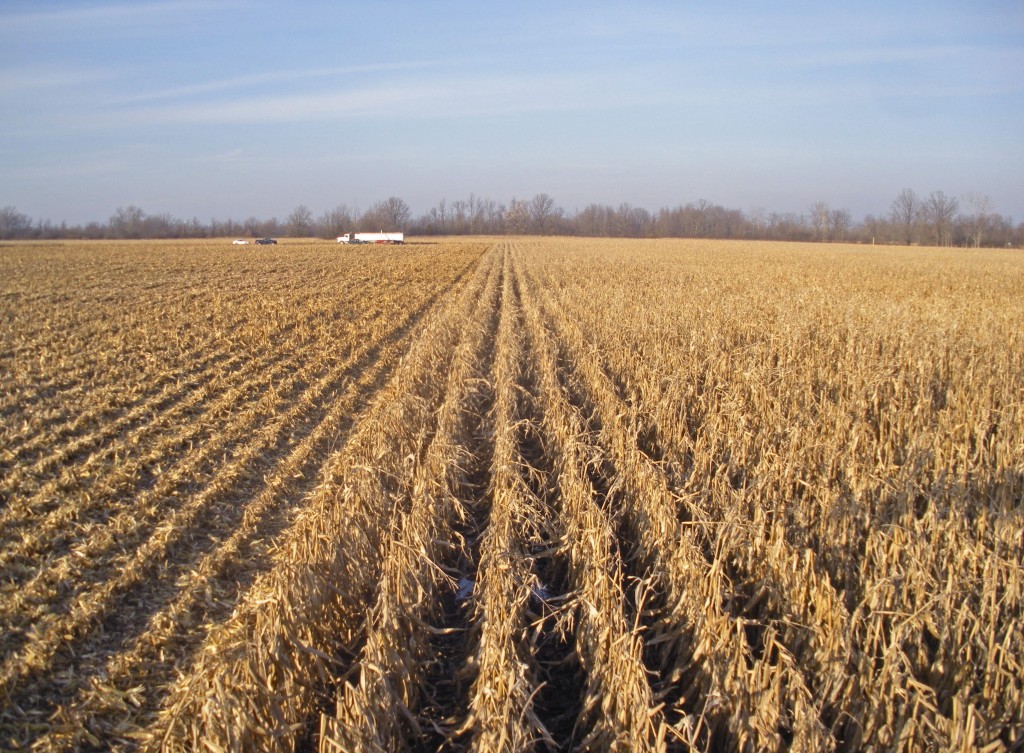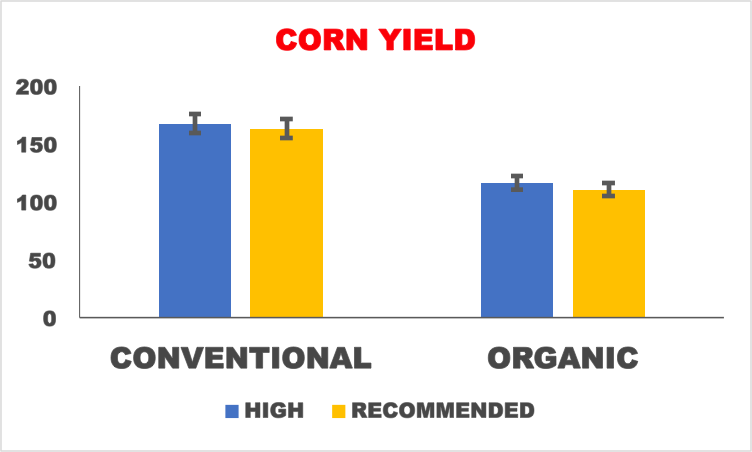Bill Cox1, Eric Sandsted1, Phil Atkins2 and Brian Caldwell1
1Soil and Crop Sciences Section – School of Integrated Plant Science, Cornell University; 2New York Seed Improvement Project – Cornell University
 We initiated a 3-year study at the Aurora Research Farm in 2015 to compare the corn, soybean, and wheat/red clover rotation under conventional and organic cropping systems during the 3-year transition period (2015-2017) to an organic cropping system. We used three entry points or previous crops from 2014 to initiate the 2015-2017 study: 1) grain corn, 2) small grain, and 3) soybean. Three of the many objectives of the study are 1) to determine the best previous crop (2014) for the transition, 2) the best crop to plant in the first year (2015) during the transition and 3) do corn, soybean, and wheat respond similarly to management inputs (high and recommended) under conventional and organic cropping systems? This article will discuss corn yields under conventional and organic cropping systems under high and recommended management inputs.
We initiated a 3-year study at the Aurora Research Farm in 2015 to compare the corn, soybean, and wheat/red clover rotation under conventional and organic cropping systems during the 3-year transition period (2015-2017) to an organic cropping system. We used three entry points or previous crops from 2014 to initiate the 2015-2017 study: 1) grain corn, 2) small grain, and 3) soybean. Three of the many objectives of the study are 1) to determine the best previous crop (2014) for the transition, 2) the best crop to plant in the first year (2015) during the transition and 3) do corn, soybean, and wheat respond similarly to management inputs (high and recommended) under conventional and organic cropping systems? This article will discuss corn yields under conventional and organic cropping systems under high and recommended management inputs.
All three fields (corn, small grain, and soybean as entry points or previous crops) were mold-plowed on May 22. Kreher’s composted chicken manure, a 5-4-3 analysis, was selected as the fertilizer for the organic corn in the transition year of this study. We estimated that about 50% of the N from the composted chicken manure would be mineralized and available to the corn crop in 2015. We applied some of the Kreher’s composted chicken manure pre-plant to the organic corn plots (50-100 lbs/actual N acre, depending upon the previous crop, and if the plot was the recommended or high input treatment) on the morning of planting, May 23, and then culti-mulched all three studies.
We used a John Deere 7200 MaxEmerge planter to plant a treated (insecticide/fungicide seed treatment) GMO corn hybrid, P9675AMXT with the AMXT, LL and RR2 traits, in the conventional cropping system; and its isoline, the untreated non-GMO, P9675, in the organic cropping system at two seeding rates, ~29,600 kernels/acre (recommended input treatment) and ~35,500 kernels/acre (high input treatment). We applied about 250 lbs/acre of 10-20-20 as a starter fertilizer treatment to corn in the conventional cropping system. In the organic cropping system, we applied about 325 lbs/acre of Kreher’s composted manure as a starter fertilizer. We also added Sabrex, an organic seed treatment with Tricoderma strains, in the seed hopper to the non-GMO, P9675, in the high input treatment in the organic cropping system.
We side-dressed the conventional corn at the V6 stage (June 26th) at 80 lbs of actual N/acre (soybean as the previous crop) and 120 lbs/acre (corn and small grain as the previous crop) with liquid N (30-0-0) in the recommended input treatment and 120 to 160 lbs actual N/acre in the high input treatment, respectively. We side-dressed composted chicken manure to organic corn at the V4 stage (June 18) at estimated N rates that would closely match the total N rates (starter and sidedress) in the recommended input treatment (105 lbs/acre total N and 145 lbs/acre total N depending upon the previous crops) and high input treatment (145 and 185 total N/acre depending upon the previous crops) of the conventional cropping system.
We applied Roundup (PowerMax) at 32 oz/acre for weed control in the conventional cropping system in both the recommended and high input corn treatments at the V6 stage (June 27). We used the tine weeder to control weeds in the row in the organic cropping system in both the recommended and high input corn treatments at the V2 stage (June 5), if corn was the previous crop, but not in the other two experiments. We then cultivated close to the corn row in both recommended and high input treatments in the organic cropping system at the V4 stage (June 20) with repeated cultivations between the rows at the V6 stage (June 25) and again at the V9 stage (July 6).
Corn yield showed a previous crop x cropping system interaction (Fig.1). Corn yields in the organic compared with the conventional cropping system was 40% less following the 2014 corn crop (165 vs. 98 bu/acre), 30% less following soybean (159 vs. 108 bu/acre), and 20% less following the small grain crop (172 vs. 135 bu/acre, respectively). As discussed previously (https://blogs.cornell.edu/whatscroppingup/2015/07/23/emergence-early-v4-stage-and-final-plant-populations-v10-psnt-values-v4-and-weed-densities-v12-in-corn-under-conventional-and-organic-cropping-systems/), corn populations were lower at the V9 stage between the organic (~25,000 plants/acre in the recommended and ~31,450 plants/acre in the high input treatments) compared with the conventional cropping system (~28,500 plants/acre in recommended and ~34,265 in high input treatments), and weed densities were much higher in the organic cropping system (~2.25 weeds/m2) compared with the conventional cropping system (~0.4 weeds/m2). Nevertheless, N status of corn crop may have been the most important factor, as indicated by visual symptoms of N deficiency, in the lower corn yields in the organic compared with the conventional cropping system.

Corn yield did not respond to input treatments, regardless of the cropping system (Fig.2). When averaged across the three previous crops, corn in the conventional cropping system yielded similarly in the high input (167 bu/acre) and recommended input treatment (163 bu/acre) and similarly in the organic cropping system (116 vs. 110 bu/acre, respectively). The dry summer conditions at the Research Farm (2.8 inches in July, 1.36 in August, and 0.28 inches from September 1-15, date of physiological maturity or black layer formation) may have contributed to the lack of response of corn to high plant populations and N rates in 2015. We also observed a lack of corn yield response to high seeding and N rates in 2010, a very high yielding year, and in 2011, a very dry year (http://scs.cals.cornell.edu/sites/scs.cals.cornell.edu/files/shared/documents/wcu/WCUVol22No.pdf).

In conclusion, corn should not be the first choice as the first-year transition crop from a conventional to an organic cropping system, based on the results of this study. Corn emerged slower and plant populations were significantly lower in the organic compared with the conventional cropping system. Also, more weeds were observed in corn in the organic compared with the conventional cropping system, which probably contributed to lower yields under organic management. Furthermore, visual observations of the N status indicated that the organic corn may have been short of N throughout the growing season (we will analyze N uptake of conventional and organic corn during the winter months). If there was a lack of N in organic corn, the lack of a red clover crop in place at the beginning of this experiment would have been a major factor. If corn is selected for the first year transition crop, a small grain crop with a red clover inter-seeding may be the best previous crop. Organic corn yields compared with conventional corn yields were only 20% lower following a small grain, even with the use of composted chicken manure as the sole source of N, and not in supplement to a red clover green manure crop.

